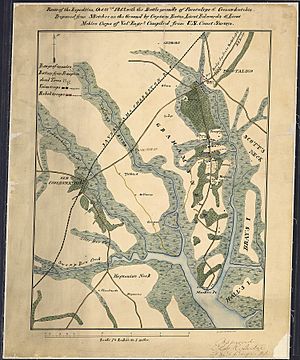Second Battle of Pocotaligo facts for kids
Quick facts for kids Second Battle of Pocotaligo |
|||||||
|---|---|---|---|---|---|---|---|
| Part of the American Civil War | |||||||
 Map of the battle and route of the expedition |
|||||||
|
|||||||
| Belligerents | |||||||
| Commanders and leaders | |||||||
| Brigadier General John M. Brannan | Colonel William S. Walker | ||||||
| Units involved | |||||||
| X Corps | Beaufort District, Department of South Carolina | ||||||
| Strength | |||||||
| 4,500 | 2,000 With additional reinforcements from Charleston | ||||||
| Casualties and losses | |||||||
| 43 killed 294 wounded 3 missing |
21 killed 124 wounded 18 missing |
||||||
The Second Battle of Pocotaligo, also known as the Battle of Pocotaligo Bridge, was a fight during the American Civil War. It happened on October 22, 1862, near Yemassee, South Carolina. The main goal for the Union army was to cut off the Charleston and Savannah Railroad. This would help to isolate the city of Charleston, South Carolina.
Contents
Who Fought: The Armies
This section lists the main groups and leaders involved in the battle.
Confederate Forces
The Confederate army was led by Colonel William Stephen Walker. His initial group included:
- 11th South Carolina Infantry (Company E)
- 1st South Carolina Sharpshooters (Companies B, C, D)
- 1st South Carolina Cavalry Battalion
- Rutledge Mounted Rifles
- Kirk's Partisan Rangers
- Charleston Light Dragoons
- Beaufort Volunteer Artillery
- Hanover Artillery
- LaFayette Artillery
Later, more soldiers joined from Charleston and Grahamville. These reinforcements included parts of the 7th and 11th South Carolina Infantry, and the 3rd and 14th South Carolina Cavalry.
Union Forces
The Union army was commanded by Brigadier General John Milton Brannan. His forces were organized into two main groups:
1st Brigade
This group was led by Colonel John Lyman Chatfield. It included:
- 6th Connecticut Volunteer Infantry
- 3rd New Hampshire Volunteer Infantry
- 4th New Hampshire Volunteer Infantry
- 48th New York Volunteer Infantry
- 76th Pennsylvania Volunteer Infantry
2nd Brigade
This group was led by Brigadier General Alfred Terry. It included:
- 3rd Rhode Island Volunteer Infantry
- 47th Pennsylvania Volunteer Infantry
- 55th Pennsylvania Volunteer Infantry
- 7th Connecticut Volunteer Infantry
Other Union units included engineers from the 1st New York Engineers, cavalry from the 1st Massachusetts Volunteer Cavalry, and several artillery batteries.
The Battle Unfolds
On October 21, 1862, about 4,200 Union soldiers left Hilton Head, South Carolina. They traveled on ships up the Broad River. Their mission was to destroy the railroad and its bridges. The next morning, they landed at Mackey Point. This spot was less than ten miles from the railroad.
Union Advance
Two regiments, the 47th and 55th Pennsylvania Infantry, began marching towards Pocotaligo. Another small group of 300 men headed up the Coosawhatchie River. Their job was to destroy a bridge there and tear up the railroad tracks.
Confederate Defense
Colonel William S. Walker, the Confederate commander, quickly called for more soldiers. He sent 200 men to guard the bridges. He also sent artillery, cavalry, and sharpshooters to meet the main Union force.
The Confederates first met the Union soldiers near Caston's Plantation. Their artillery fired, but they soon had to retreat when the Union cannons fired back.
Fighting at the Marsh
Walker's men slowly pulled back to their defenses at Pocotaligo. The Union troops followed them. The Confederates were positioned across a muddy marsh, which made it hard for the Union to advance.
Brigadier General Alfred Terry ordered the 7th Connecticut Infantry forward. These soldiers had special Sharps rifles that could fire quickly. Their fast firing helped to stop the Confederate attack across the marsh. Both sides fired cannons and muskets for over two hours.
Confederate Reinforcements Arrive
As the day ended, more Confederate soldiers arrived. The Union troops were also running low on ammunition.
After the Battle
As it got dark, General Brannan realized they could not reach the railroad bridge. He ordered his troops to retreat back to Mackey Point. The Confederate Rutledge Mounted Rifles and Kirk's Partisan Rangers chased them. However, the Union rearguard, including the 47th Pennsylvania Infantry Regiment, held them off.
Brannan's soldiers got back on their ships the next morning. They returned to Hilton Head. The Confederates had successfully defended the railroad.

